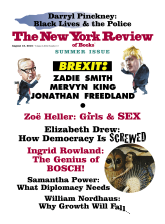In response to:
Transforming Our View of the Law from the June 23, 2016 issue
To the Editors:
I have only now become aware of a stunningly misleading sentence in Jeremy Waldron’s review of David Cole’s excellent book Engines of Liberty [NYR, June 23], regarding Cole’s explanation for the triumph of the “individualist” interpretation of the Second Amendment in the US Supreme Court. “The NRA may have supported some academic writing,” Waldron writes, “by constitutional scholars like Stephen Halbrook and Sanford Levinson.”
It is certainly true that Professor Cole selects out a 1989 essay that I published in The Yale Law Journal for special comment and describes it, rightly or wrongly, as the single most important scholarly essay on the topic. But he does not suggest, because it would have been totally and utterly false, that it was in any way “supported” by the NRA in any sense other than the fact that after publication the NRA was pleased to publicize, without any encouragement from me, a wholly independent article published by a liberal law professor in one of the major law journals in the United States.
The gestation of the essay had literally nothing to do with the NRA; instead, I was invited to participate in a symposium at Williams College on the occasion of the bicentennial of the Bill of Rights. I wrote on the Second Amendment because I was truly curious as to what it was doing in the Constitution at all. I came to the thoroughly honest—though some people believe it to be mistaken—conclusion that it had almost literally nothing to do with classic “self-defense” and everything to do with a civic republican argument that “the people” as a collectivity were entitled to keep and bear arms for potential use in armed insurrection against a tyrannical government.
That had, of course, been the experience of many American patriots in 1775–1781. As a matter of fact, I have been publicly critical of Justice Scalia’s majority argument in the Heller case precisely because, like most lawyers, whether conservative or liberal, he preferred to ignore the “insurrectionist” origins of the amendment in favor of a tendentious and I think insupportable rewriting of American legal history turning the amendment, as understood in 1791, into the protection of an individual right to defend oneself against criminals trying to break into one’s home.
In any event, I would hope that my friend Jeremy Waldron will agree that any failings I may have as a scholar of the Second Amendment do not include being subsidized or otherwise influenced by any “ support” from the NRA or, for that matter, any other of the manifold organizations so ably described by Professor Cole in his delineation of the debate over guns as an issue of both public policy and American constitutional law.
Sanford Levinson
W. St. John Harwood and W. St. John Harwood Jr. Centennial Chair in Law Professor
Department of Government
University of Texas at Austin Law School
Austin, Texas
Jeremy Waldron replies:
I am happy to accept Professor Levinson’s correction and his statement that his work on the Second Amendment was not supported by the National Rifle Association. David Cole’s book makes it clear that any “support” went in the other direction:
Perhaps the most valuable independent support, however, came in 1989, when Levinson, a well-respected liberal law professor at University of Texas, published “The Embarrassing Second Amendment” in the Yale Law Journal. What was embarrassing, according to Levinson, was the fact that the historical evidence for an individual right to bear arms was much stronger than most legal scholars had thought….
I apologize for the misleading characterization in my review of Engines of Liberty.



